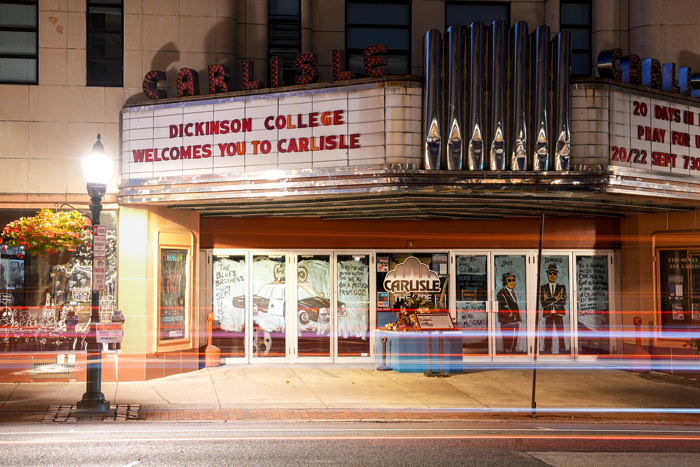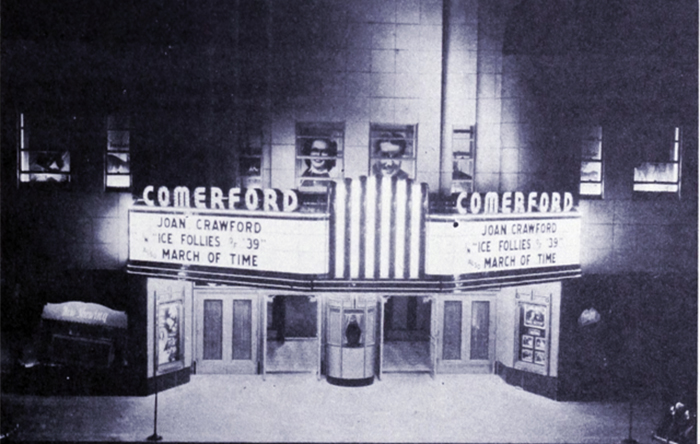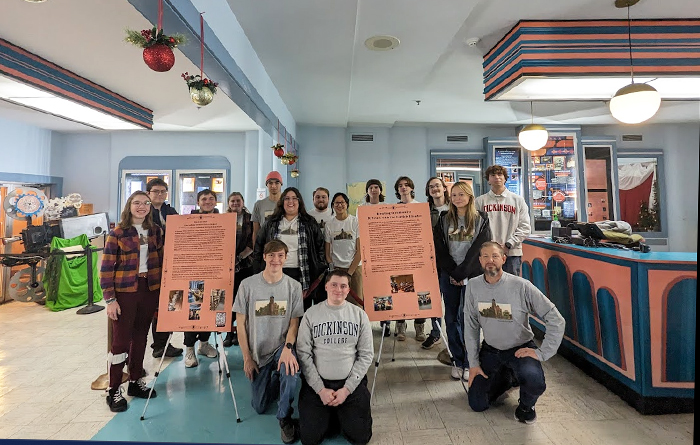Beyond the Marquee: Dickinson Students Uncover ‘Gem of Carlisle’

Students unbox history of storied Carlisle Theatre
by MaryAlice Bitts-Jackson
A stroll in downtown Carlisle just wouldn’t be same without High Street’s glimmering Carlisle Theatre marquee. A jewel in the crown of the town’s eclectic architecture, the theatre gives us a peek at a past way of life, when a slim quarter bought children an afternoon of cinema magic and grown-ups dressed up for a 35-cent movie night on the town. Notably, though much has changed, the theatre remains a hub of community activity in 2023.
Students of Professor of History Karl Qualls have been researching the theatre’s history and its enduring mission to bring shared entertainment—and art deco style—to the region. They recently presented their scholarship to members of the local community.
A Carlisle first

The Carlisle Theatre was originally named The Comerford. It was renamed the Carlisle Theatre in 1950.
Named to the National Register of Historic Places, the “Gem of Carlisle” opened in May 1939 as the Comerford Theatre and was redubbed the Carlisle Theatre in 1950. It was the most lavish theatre in town, and the first downtown building to boast air conditioning. Business remained strong until the 1970s, when moviegoers flocked away from downtown movie houses and toward big cineplexes. The theatre closed in 1986. After a major fundraising and renovation effort, its doors reopened in 1993.
Setting the stage
Before Qualls’ students could deep-dive into this long history, they needed access to the Carlisle Theatre’s documents. And before that, the documents needed to be retrieved from their informal storage in the theatre’s basement and organized.
Enter Emma Rodrigues ’25 (English, history) who completed an archiving internship last summer with Qualls. Scores of boxes were removed from the basement and placed in Dickinson’s Archives & Special Collections department for temporary storage as Rodrigues and Qualls catalogued, inventoried, described and preserved the documents in acid-free folders. Students in Qualls’ fall class were then able to research in the documents’ on-campus, temporary home.
Challenges and rewards

Students in a class taught by Professor of History Karl Qualls (first row, far right) pose in front of two of their displays on Carlisle Theatre's history. Photo courtesy of Qualls.
Each student researched one aspect of the Carlisle Theatre’s history. For most, if not all, this was their first major research project—and their first time working only with primary sources on paper.
Ty Allport ’26 (history) spent roughly 70 hours poring over handwritten meeting minutes and survey proposals to investigate the once-neglected building’s extensive renovations. He estimates it took roughly two to three times longer to decipher handwritten documents, compared to typewritten ones. After sharpening that useful skill, Allport emerged impressed that the extensive renovations, funded entirely by donations and completed by expert volunteers, took only a few years.
Owen Barry ’26 (history) studied the theatre’s financial records. The music fan was thrilled to discover that, in addition to showing films and hosting local stage productions, the Carlisle Theatre has brought national acts to Carlisle, like blues legend B.B. King. Barry was also amazed to learn that in 2005, while downtown movie theatres struggled nationwide, the Carlisle Theatre attracted a combined 1,731 audience members over four showings of a nature documentary.
From classroom to community
After writing their research papers, the students created public history displays. The displays were recently unveiled at the theatre, and students were on hand in the theatre lobby to answer questions about their findings. The displays will remain in the lobby through the end of the year.
Kimberly Tyson ’26’s (history) display provided a broad overview of the theatre and its evolving relationship with the Carlisle community, which she constructed by poring over newspaper clippings about the theatre’s community service during World War II. Tyson was inspired to learn that, in addition to contributing to drives in conjunction with organizations like the Red Cross, the theatre promoted war bonds by offering special screenings for bond-holders. Her desire is that, by learning about this service, others will be similarly inspired.
“I hope that the theatre board will be able to use the work that my classmates and I have done, including both our presentations and our papers, to make informed decisions about where they want to take the theatre next,” Tyson says.
TAKE THE NEXT STEPS
Published December 18, 2023